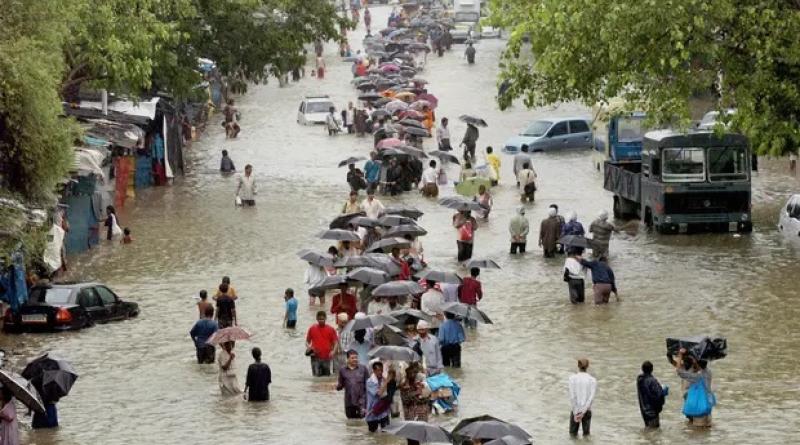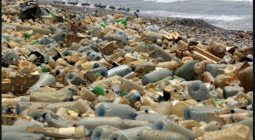Plastic waste puts millions of world’s poorest at higher risk from floods

A devastating 2005 flood that killed 1,000 people in the Indian city of Mumbai was blamed on a tragically simple problem: plastic bags had blocked storm drains, stopping monsoon flood water from draining out of the city.
Now a new report, attempting to quantify this problem, estimates that 218 million of the world’s poorest people are at risk from more severe and frequent flooding caused by plastic waste.
The number is equivalent to the population of the UK, France and Germany combined. About 41 million of those are children, older people and people with disabilities, the report found. Three-quarters of those most at risk live in south-east Asia and the Pacific region.
Researchers from Resource Futures, an environmental consultancy, and Tearfund, an international Christian charity, found that communities in Cameroon, Nigeria, the Democratic Republic of the Congo (DRC), Ghana, Bangladesh and Indonesia had experienced more severe flooding due to plastic waste blocking drainage systems in the last few years. In these communities, plastic waste was a “risk multiplier” for flooding, they said.To identify those most at risk, they used a study of flood risk and poverty published in 2022 by Jun Rentschler and others that identified 1.8 billion people at high risk of flooding in 188 nations. They narrowed their analysis to only low and middle-income countries with inadequate urban drainage, solid waste management and sanitation. To focus on the populations most at risk from plastic exacerbating the flood risk, they also excluded countries with mismanaged waste of less than 1kg for each person a year, and focused on urban slums.
Rich Gower, a senior economist and policy associate at Tearfund, said: “Around the world, from Brazil to the DRC, from Malawi to Bangladesh, we see plastic pollution making floods worse. Without decisive action, this problem is only going to get worse.”
Plastic waste pollution has doubled in the last decade, and is predicted to triple by 2060. Only 9% is recycled globally.
Gower said: “The aim of the report is to give an order of magnitude to the number of people at risk. What we are saying is that plastic pollution affects the poorest, most marginalised communities the most. We’ve seen it with plastic burning, and we are now seeing it with flood risk. These communities bear the brunt of plastic pollution.”The authors stressed the limitations of the estimate. It was based on the best available data, they said, admitting that “detailed data on impacts of plastic-aggravated flooding is not available”. Neither, they said, was there sufficient modelling of the links between plastic pollution, flooding and health. But they had applied “multiple conservative assumptions and sense-checks”, and considered the estimate “realistic and conservative”, they said.
Gower urged governments, which will come together in Paris next week to begin negotiations on a legally binding plastics treaty, to consider these worst-affected communities. “Through the plastics treaty, world leaders have a once-in-a-lifetime opportunity to end this crisis by driving down plastic production and making sure the rest is safely collected and recycled,” he said.
Brendan Cooper, a consultant at Resource Futures, said they used the Rentschler flood-risk study as a starting point. “We then broke that down to those more in line with plastic-aggravated flooding,” said Cooper. “We found urban areas have high levels of mismanaged waste.”
While the figures were estimated, he said, they were a “conservative” estimate.
Densely populated slums in south Asia, east Asia and Pacific and sub-Saharan Africa were likely to be experiencing the worst effects of plastic-aggravated flooding due to rapid, poorly planned development, with limited flood-mitigation infrastructure, the report found.
It showed that plastic pollution in slums in many low and middle-income countries was making flooding more severe by blocking drainage systems, resulting in health problems, including gastrointestinal diseases such as cholera and diarrhoeal disease.
The researchers excluded coastal communities and small-island developing states from the research, as coastal flooding is unlikely to be aggravated by plastic waste.
More than 1 billion people live in slums globally, and this is expected to reach 3 billion by 2050. The most commonly observed plastic items blocking drainage systems, the report found, were bottles, nylon threads from the fishing industry, plastic bags and sachets.
The study said the accumulation of plastic pollution could cause the water level to rise by one metre within the first hour of a flood.
cover photo:People walk on a flooded street after torrential rains paralysed Mumbai in July 2005. Photograph: Sebastian D’Souza/AFP/Getty Images





